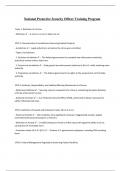National Protective Security Officer Training Program
Topic 1: Definition of a Crime
- Definition ✔️: A crime is an act or failure to act.
EPO 3: Characteristics of Jurisdictions Governing Federal Property
- Jurisdiction ✔️: Legal authority to act where the crime was committed.
- Types of Jurisdiction:
1. Exclusive Jurisdiction ✔️: The federal government has complete law enforcement authority;
state/local cannot enforce laws here.
2. Concurrent Jurisdiction ✔️: State grants law enforcement authority to the U.S. while retaining some
authority.
3. Proprietary Jurisdiction ✔️: The federal government has rights to the property but not full state
authority.
EPO 4: Authority, Responsibility, and Liability Affecting Detainment of a Person
- Detainment Defined ✔️: Securing a person suspected of a crime or conducting disruptive behavior
until law enforcement arrives.
- Authority to Detain ✔️: As a Protective Security Officer (PSO), authorized to detain necessary for
safety, following state laws.
EPO 5: Definition of Assault and Protection Under 18 U.S.C § 111
- Historical Context ✔️: 2011 statistics show significant instances of aggravated assaults, largely
committed with personal weapons or firearms.
- Definition of Assault ✔️: A willful attempt or threat to inflict injury with apparent ability to do so,
causing fear of immediate harm.
- Protection Under 18 U.S.C §111 ✔️: Protects U.S. government employees, including PSOs assisting
them.
EPO 6: Federal Management Regulations Governing Federal Facilities
,- Regulations ✔️: Governed by Title 41 CFR Part 102-74, Subpart C, which includes regulations about:
- Narcotics and Other Drugs
- Breastfeeding: Allowed in publicly accessible areas.
- Nondiscrimination: Prohibits discrimination of various types.
EPO 7: Facility Rules and Administration Process
- Facility Security Committee (FSC) ✔️: Composed of federal tenants, works with FPS for security
functions and changes.
EPO 1: Understanding Physical Appearance and Uniform Standards
- Appearance Standards ✔️: High standards for PSOs to enhance professionalism and trust.
- Professionalism: Maintain a courteous yet firm demeanor, even under duress.
EPO 2: Acceptable vs. Unacceptable Conduct
- Acceptable Conduct ✔️: Includes being on time, in proper uniform, and with required equipment.
- Unacceptable Conduct ✔️: Includes eating or drinking on duty, engaging with personal electronic
devices, sleeping, or socializing while on duty.
Interacting with Children
- Guidelines ✔️: Balance friendliness with firmness; do not display weapons or handcuffs to children.
EPO 1: Operational Functions of the MegaCenter
- MegaCenters ✔️: Locations that operate 24/7, providing critical services such as alarm monitoring and
dispatch of law enforcement.
EPO 2: Proper FPS Communication Procedures
- Incident Reporting: Criteria to report unusual behavior, unsecured items, alarm activations, etc.
- Radio Use: Key descriptive elements when communicating information about individuals and vehicles
using the acronym CYMBLS (Color, Year, Make, Body, License plate number, Style).
, EPO 1: PSO Facility Safety Procedures
- Safety Protocols: Knowledge of fire regulations, locations of extinguishers, emergency plans, etc.
General Components of a Fire Alarm System
- Components ✔️: Include a control unit, initiating devices (detectors), and indicating devices for
monitoring fire signals.
You may encounter a fire during patrol. If you encounter a fire, dial 911 immediately and contact the FPS
MegaCenter.
EPO 2: Identify the Different Classifications of Fires and Extinguishers
Topic 1: Classifications of Fires ✔️Topic 1: Classifications of Fires:
-Class A: Fire involves with Wood, Cloth, paper (ordinary combustibles)
-Class B: Fire involves with Liquid, gas, alcohol, oil paint
-Class C: Fire involves with electrical equipment
-Class D: Fire involves with combustible Metals, magnesium, titanium, sodium
-Class K: Fire involves vegetable oil, fats (think K=Kitchen)
-Class BC: Flammable liquids and energized electrical equipment
-Class ABC: Ordinary combustibles, flammable liquids and energized electrical equipment
Multipurpose Extinguishers
Most portable extinguishers are rated for use with more than one classification of fire. For example, an
extinguisher with a BC rating is suitable for use with fires involving flammable liquids and energized
electrical equipment. Elect and burning Liquid.
Topic 2: Classifications of Fires and Extinguishers
Carbon Dioxide Extinguishers: ✔️The approximate effective range is up to 10 feet. CO2 is most effective
when used close to the fire. Ensure that the gas penetrates casings of electric motors or switchboards
etc.




